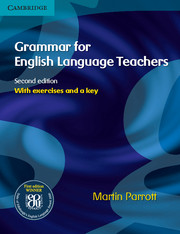Introduction to Part C
Published online by Cambridge University Press: 09 February 2023
Summary
Whereas the chapters in Parts A and B of this book deal with grammar at the level of words or short phrases, those in Part C look at longer stretches of language, and are concerned with the function that different words or groups of words can perform in sentences.
In Chapters 20–22 we look at the organisation of different key elements in sentences.
Chapter 20 ‘Sentence constituents: basic principles’ concentrates on the basic sentence, showing how we make up and order the key elements of noun phrase, verb phrase and adverbials. Central to this are the concepts of subject and object. For example:
Chapter 21 ‘Sentence constituents: major variants’ looks in more detail at ways we can vary this basic order. For example:
Chapter 22 ‘Passive constructions’ focuses on a specific case where we change the basic order: passive constructions. For example:
Chapter 23 ‘Discourse markers’ looks at some of the words and expressions we use to:
• show the logical links between different sentences and parts of sentences.
• ‘manage’ our participation in conversation.
• infl uence how our listeners or readers react.
• express our attitude to what we are saying or writing.
For example:
Logical links: alternatively, firstly, on the other hand
Expressing attitude: obviously, unfortunately
Chapter 24 ‘Ellipsis and substitution’ looks at how we leave out parts of sentences, and sometimes replace them with words or expressions which stand in place of them. In the examples that follow, square brackets show the information that is left out and the word in capital letters stands in for something else:
[ ] Got a cold [Have you]
Mary answered the mail and her secretary [ ] the faxes [answered]
I’ve got some stamps. Do you want ONE (a stamp)
- Type
- Chapter
- Information
- Grammar for English Language Teachers , pp. 290 - 291Publisher: Cambridge University PressPrint publication year: 2010



